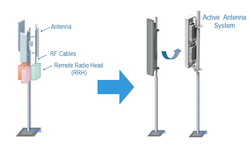5G Absolute Radio Frequency Channel Number (NR-ARFCN)
An Absolute Radio-Frequency Channel Number (ARFCN) is a code that specifies a pair of reference frequencies used for transmission and reception in radio system. In a FDD system one ARFCN number is required for downlink and another for uplink as downlink and uplink frequencies are different while for TDD system only one ARFCN number is enough as downlink and uplink frequency remains same.
Term ARFCN started from GSM and evolved with the new technologies like it was know as UARFCN for UMTS/WCDMA, named as EARFCN for E-UTAR/LTE and now renamed as NR-ARFCN for 5G/New Radio. NR-ARFCNs for 5G new radio are defined in 3GPP specification 38.101-1 and 38.101-2.
NR Band Types:
- Frequency Division Duplex (FDD) Band
- Time Division Duplex (TDD) Band
- Supplement Downlink (SDL) Bands
- Supplement Uplink (SUL) Bands
NR-ARFCN Per Operating Band (FR1 < 6GHz)
| NR Band | Band Alias | Duplex Mode | ΔFRaster (kHz) |
Uplink Range of NREF (First – <Step size> – Last) |
Downlink Range of NREF (First – <Step size> – Last |
| n1 | 2100 | FDD | 100 | 384000 – <20> – 396000 | 422000 – <20> – 434000 |
| n2 | 1900 PCS | FDD | 100 | 370000 – <20> – 382000 | 386000 – <20> – 398000 |
| n3 | 1800 | FDD | 100 | 342000 – <20> – 357000 | 361000 – <20> – 376000 |
| n5 | 850 | FDD | 100 | 164800 – <20> – 169800 | 173800 – <20> – 178800 |
| n7 | 2600 | FDD | 100 | 500000 – <20> – 514000 | 524000 – <20> – 538000 |
| n8 | 900 | FDD | 100 | 176000 – <20> – 183000 | 185000 – <20> – 192000 |
| n20 | 800 | FDD | 100 | 166400 – <20> – 172400 | 158200 – <20> – 164200 |
| n28 | 700 APT | FDD | 100 | 140600 – <20> – 149600 | 151600 – <20> – 160600 |
| n38 | TD 2600 | TDD | 100 | 514000 – <20> – 524000 | 514000 – <20> – 524000 |
| n41 | TD 2500 | TDD | 15 | 499200 – <3> – 537999 | 499200 – <3> – 537999 |
| n50 | TD 1500+ | TDD | 100 | 286400 – <20> – 303400 | 286400 – <20> – 303400 |
| n51 | TD 1500- | TDD | 100 | 285400 – <20> – 286400 | 285400 – <20> – 286400 |
| n66 | AWS-3 | FDD | 100 | 342000 – <20> – 356000 | 422000 – <20> – 440000 |
| n70 | AWS-4 | FDD | 100 | 339000 – <20> – 342000 | 399000 – <20> – 404000 |
| n71 | 600 | FDD | 100 | 132600 – <20> – 139600 | 123400 – <20> – 130400 |
| n74 | L-Band | FDD | 100 | 285400 – <20> – 294000 | 295000 – <20> – 303600 |
| n75 | DL 1500+ | SDL | 100 | N/A | 286400 – <20> – 303400 |
| n76 | DL 1500- | SDL | 100 | N/A | 285400 – <20> – 286400 |
| n77 | TD 3700 | TDD | 15 | 620000 – <1> – 680000 | 620000 – <1> – 680000 |
| n78 | TD 3500 | TDD | 15 | 620000 – <1> – 653333 | 620000 – <1> – 653333 |
| n79 | TD 4500 | TDD | 15 | 693334 – <1> – 733333 | 693334 – <1> – 733333 |
| n80 | UL 1800 | SUL | 100 | 342000 – <20> – 357000 | N/A |
| n81 | UL 900 | SUL | 100 | 176000 – <20> – 183000 | N/A |
| n82 | UL 800 | SUL | 100 | 166400 – <20> – 172400 | N/A |
| n83 | UL 700 | SUL | 100 | 140600 – <20> –149600 | N/A |
| n84 | UL 2100 | SUL | 100 | 384000 – <20> – 396000 | N/A |
NR-ARFCN Per Operating Band (FR2 > 6GHz)
| NR Band | Band Alias | Duplex Mode | ΔFRaster (kHz) |
Uplink Range of NREF (First – <Step size> – Last) |
Downlink Range of NREF (First – <Step size> – Last |
| n257 | 28 GHz | TDD | 60 | 2054167 – <1> – 2104166 | 2054167 – <1> – 2104166 |
| n258 | 26 GHz | TDD | 60 | 2016667 – <1> – 2070833 | 2016667 – <1> – 2070833 |
| n260 | 39 GHz | TDD | 60 | 2229167 – <1> – 2279166 | 2229167 – <1> – 2279166 |
NR-ARFCN Calculation:
The relation between the NR-ARFCN and the RF reference frequency FREF in MHz for the downlink and uplink is given by the following equation, where FREF-Offs and NRef-Offs depend on frequency range are given in table below and NREF is the NR-ARFCN.
- FREF = FREF-Offs + ΔFGlobal (NREF – NREF-Offs) (i)
- NREF = NREF-Offs + (FREF – FREF-Offs) / ΔFGlobal (ii)
Equation (i) can be used when you need to calculate center frequency FREF for given NR-ARFCN. Equation (ii) can be used when you need to calculate NR-ARFCN for a given center frequency.
| Frequency range | ΔFGlobal | FREF-Offs [MHz] | NREF-Offs | Range of NREF |
| 0 – 3000 MHz | 5 kHz | 0 MHz | 0 | 0 – 599999 |
| 3000 – 24250 MHz | 15 kHz | 3000 MHz | 600000 | 600000 – 2016666 |
| 24250 – 100000 MHz | 60 kHz | 24250 MHz | 2016667 | 2016667 – 3279167 |
NR-ARFCN Calculation Example:
Lets consider given frequency is 2120 MHz from NR band n1, then NREF (NR-ARFCN) can be calculated using above equation (ii). Get all the value for equation:
- NREF-Offs = 0 (Because 2120 is with in the range of 0 – 3000 MHz)
- FREF = 2120 MHz (Given Frequency)
- FREF-Offs = 0 (Because 2120 is with in the range of 0 – 3000 MHz)
- ΔFGlobal = 5KHz
Putting all value in equation
- NREF = 0 + (2120 MHz – 0 ) / 5KHz
- NREF = 2120 MHz/ 5KHz = 424000 will be the NR-ARFCN
Reference Frequency Calculation Example:
Lets consider given NR-ARFCN is 670000 from NR band n77, then FREF (center frequency) can be calculated using above equation (i). Get all the value for equation:
- NREF-Offs = 600000 (Because 670000 is with in the range of 600000 – 2016666)
- NREF = 670000 (Given NR-ARFCN)
- FREF-Offs = 3000 MHz (Because 670000 is with in the range of 600000 – 2016666)
- ΔFGlobal = 15KHz
Putting all values in equation
- FREF = 3000 MHz + 15KHz x (670000 – 600000)
- FREF = 3000 MHz + 15KHz x 70000
- FREF = 3000 MHz + 1050 MHz = 4050 MHz will be the center frequency
Related Post:
- 5G Technology Requirements
- 5G – What Makes It Different & How Does It Impact Your Business
- 5G and 4G Comparison
- 5G NR (New Radio) Frequency Bands
- 5G Absolute Radio Frequency Channel Number (NR-ARFCN)
- 5G Cell Phone Architecture
- 5G/4G ARFCN Calculator Android App
- 5G mmWave Spectrum
- 5G Frequency Bands



